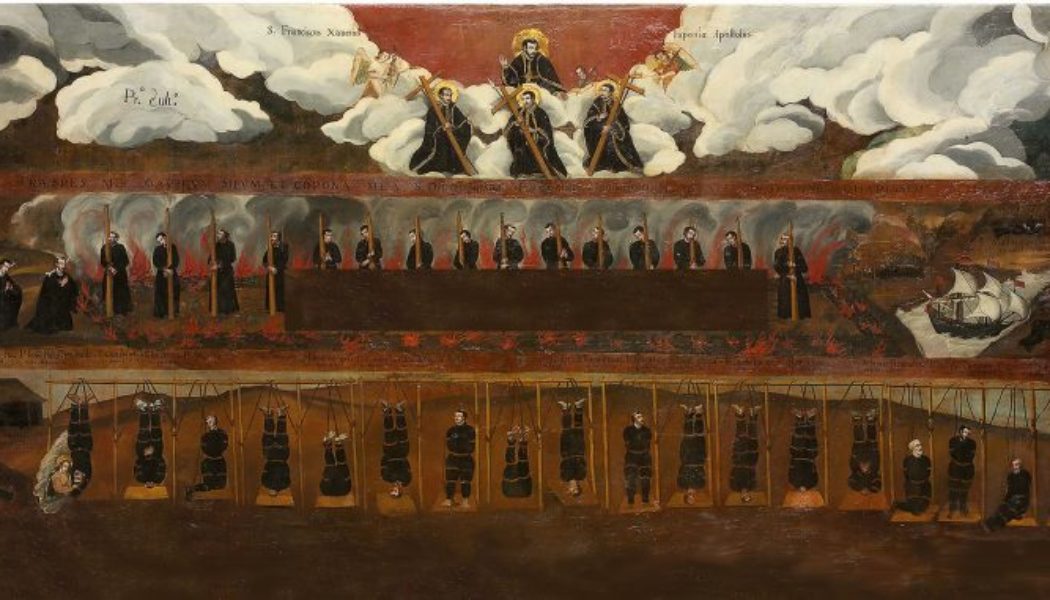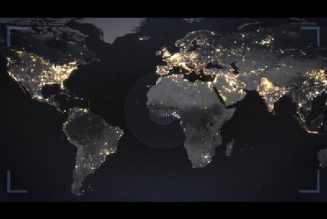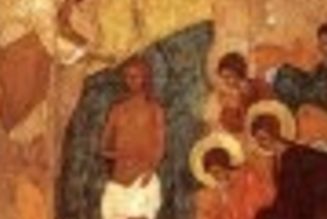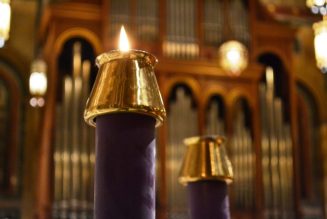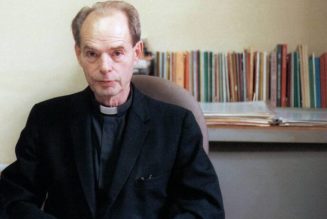
Many people know of the successful 16th-century establishment of the Church in Japan by Catholic missionaries, including St. Francis Xavier, and its repression by imperial authorities and eventual complete suppression of the Church by the Tokugawa Shogunate in 1620. Shusako Endo’s 1966 novel Silence depicted the brutality of the repression of Catholics in memorable scenes.
eventual complete suppression of the Church by the Tokugawa Shogunate in 1620. Shusako Endo’s 1966 novel Silence depicted the brutality of the repression of Catholics in memorable scenes.
Today’s feast of the first of the Japanese martyrs, St. Paul Miki, along with his companions (known as the 26 Martyrs of Nagasaki), is representative of that brutality. Miki, a native Japanese who had joined the Jesuits and successfully made many converts, was sent on a forced march from Kyoto to Nagasaki in early 1597. Having reportedly sung the Te Deum over the entire 600 miles, he was then crucified and run through with a lance as he forgave his murderers.
The Catholic faith did not die out entirely, however. One of the first things done by Catholic missionaries who returned to Japan after the country was opened up to foreigners in the late 1850s was to find any “hidden Catholics,” those who had had the faith handed down to them to be kept in secret during the two-plus centuries of the Shogunate’s ban on Christian faith.
Kei Uno, a Japanese Catholic scholar who has written extensively on Japanese education and the influence of John Henry Newman on modern Japanese Catholicism, writes in his 2021 volume, A Survey of Catholic History in Modern Japan, that on February 17, 1865, the newly-built Ōura Catholic Church was dedicated to the 26 Martyrs of Nagasaki. A couple dozen Japanese men, women, and children stood outside. When the French missionary, Fr. Petitjean, opened the doors, they came in with him. “Three elderly women knelt down next to him and joined him in prayer. Finally, one of them, Isabelle Yuri Sugimoto, turned to him and said, ‘Our hearts are the same as yours.’ Another asked, ‘Where is the statue of Mary?’” After seeing the statue, these Catholics whose families had kept the faith for seven generations explained that they had been taught that there would be three signs of authentic Catholic priests: 1) they would honor the Pope in Rome; 2) they would be celibate; and 3) they would show honor to the Blessed Virgin. As Uno writes, it was said that when Pope Pius IX received Fr. Petitjean’s letter telling of this event, he “shed tears of joy.”
This land of the Rising Sun had seen the Son of Righteousness rise and then fall in esteem. And yet now he was rising again. Uno describes the first twenty years of modern Catholic history as a “missionary period” that ended with the death of the by-then Bishop Petitjean in 1884. During this period, things were not easy. When the Shogunate ended in 1868 and power was transferred back to the Emperor (known as the Meiji Restoration), the initial impulse was to keep Christianity officially illegal, even though a series of treaties in 1858 had allowed both Americans and, significantly for the Catholic Church, the French to build churches in Japan. By 1873, however, under Western diplomatic pressure, including from President Ulysses S. Grant, the Emperor officially granted religious freedom to the Japanese themselves.
The growth was quick. By 1882, many converts had joined those hidden Catholics in the pew and native Japanese priests were being ordained. In the years after, a period of normalization of the faith and building of institutions, several religious orders, most significantly the Marianists, had the goal of converting “the educated class in Japan” and bringing “the faith to the intellectuals and leaders in society through rigorous education for all, regardless of their educational affiliation.”
Despite some controversy over whether the schools were proselytizing during school time, the initiative was successful. Uno introduces the reader to important alumni of Marianist schools such as Sōichi Iwashita (1889-1940) and Bunkei Totsuka (1892-1939). Both went on to gain stellar educations, were ordained as priests, and established significant initiatives to build up authentic Catholic culture in Japan. These and other Japanese Catholic intellectuals were significant because they were able to appeal to traditional Japanese moral values in a way that was coherent in a time at which the Imperial government was tossed back and forth between Confucian philosophy and Japanese tradition on the one hand, and liberal and utilitarian ideas on the other. Uno credits the incredible growth during this period of the Church to an external factor, “the favorable condition for Catholics” under the Emperor, and an internal factor, “compatibility between Catholic and Japanese moralities.”
During the early twentieth century this success was not unnoticed—or unopposed. Uno shows how some Japanese intellectuals attacked Christianity as introducing (no new thing for Christians) a dual loyalty that made its adherents treacherous to the nation. To display the aforementioned incoherence between traditional Japanese and modernist influences, Uno observes that one of the most virulent critics, Hiroyuki Katō, in arguing that national allegiance trumps morality, was channeling social Darwinism—and was likely influenced by German theorists of the time.
Yet it was not always completely clear to all Japanese Catholics how exactly to approach their country’s increasing militarism. Japan’s expansion into Manchuria was defended by many Catholics (with tacit support from the Holy See) because of the threat of Communism in China at the time. Threading the tightrope of defending some military adventures without defending a thoroughgoing expansionism was extremely difficult. Fr. Leo Paul Ward, the brother of Maisie Ward, was considered by his sister to have gone overboard with his support of the government in the 1930s. By the time of World War II, however, he acknowledged that things had gone awry.
While some Catholic intellectuals began to propose a strict dividing line between East and West, the best of the Japanese Catholic intellectuals saw that though an assimilation of Japanese thought and culture into the Catholic Church was a good, it had to be a true assimilation according to the teachings of the Catholic Church. After Japan’s surrender, Uno shows, there was a continuation of a successful “inculturation” that had begun in the 1930s. Yet there were warning signs lighting up. Though under General MacArthur’s governorship, Christianity was favored, Uno observes that the general himself was reticent to suppress communism in the country. The country’s Communists were able to gain traction under the guise of promoting pacifism. In education, a government blueprint titled The Guide to New Education in Japan promoted a rationalist and scientific notion of education in which religion was treated as a superstition. In the wake of these developments, some Catholics started to propose that just war theory was now obsolete and soft-pedal claims of miracles.
Leadership in the Japanese Church remained strong. Vatican II’s emphasis on dialogue with other religious and philosophical traditions was not seen as radical because such dialogue and common action—such as joint opposition to Communism and atheism by Buddhists and Catholics—had been practiced for decades before. Acknowledging the truth present outside the visible Catholica did not mean neglecting the exclusive and absolute claims of Christ or the Church. Uno sees the real problems coming a generation later in the 1980s.

Japanese intellectuals, including both clerics and writers such as Shusako Endo, began to move from inculturation to an outright ignoring or even rejection of Catholic tradition. Bishop Fumio Hamao, a Tokyo auxiliary, gave a 1978 address urging people in the pews to “attend to Asian values and tradition,” as Uno summarizes, but refrained from talking about dogma or doctrine. Endo himself “portrayed Jesus as a person who unconditionally accepted everyone. For him, Jesus was a tender and maternal figure. He did not include descriptions of Jesus as judging humanity, nor did he speak much about the traditions and doctrines of the Catholic Church.” The reader might observe that it is amazing how such “Asian” takes on things correspond so closely to what Western intellectuals were peddling. Bishop Hamao was a graduate of the Gregorian University.
It was in 1987, however, that things really went off the rails. Uno describes how the Japanese bishops held the first National Incentive Convention for Evangelization in November of that year. Anyone familiar with C. S. Lewis’s That Hideous Strength will find the acronym NICE a bit chilling. This conference talked about subsidiarity in the Church, but its main effect was a centralization of the Japanese Church. This “top-down” event was advertised as providing “the People’s voice,” but Uno shows how it was actually managed by the bishops and a few clerics. And the pitching overboard of dogma, doctrine, and Christian morality was a key part of this. A Japanese bishops’ letter declared, “By announcing Good News of Christ in God[‘s] Presence, we want to change from being a faith perceived as putting first emphasis on rules and doctrines, to one that puts primary emphasis on life, especially on joyfully living life together.” Uno notes that the extreme optimism about the world is connected with downplaying of such doctrines as original sin in this period.
As with almost every similar initiative in the post-conciliar era, such attempts at painting the faith in beige were not left unchallenged. Uno writes of how a group of distinguished scholars designated as the Yokohama Action Group protested that NICE I had flagrantly violated the liturgical norms in their liturgies and had opened up the Church to leftist infiltration by their focus on social and political matters.
This political focus of the Japanese bishops continued for several decades. Uno looks particularly at an episode in 2015 when the Japanese bishops engaged in outright politicking against the Abe government’s legislation on military affairs. While he defends the rights of bishops to intervene politically, he notes that such interventions as this one were inappropriate due to their conflating moral judgments with political solutions, endangering the Church’s status as a transpolitical institution that is not to be identified with particular political systems.
Is there hope for the Church in Japan? In his introduction, Uno describes his own childhood experiences with the Church that gave him an “awe of God” and led to his own conversion to Catholicism. He does not see the Church as providing that awe in the same way today due to the changes he highlights. But there may well be hope. In the final pages of the book, he discusses the Archdiocese of Tokyo’s Directives on Evangelization and Pastoral Care, released in 2020. In contrast to the NICE documents and initiatives of the previous three decades, Uno writes, “It made manifest the image of the Holy Triune God to the world and stated that the mystery of communion lay at the heart of the Church.”
Uno’s book, though suffering from the defects of poor editing of the English, is a fascinating and short account of how the Faith survived the Shogunate’s suppression and may well survive the depressing leadership of Japanese bishops and intellectuals that has characterized the last three decades. This land may see the Rising Son shine once again. Oremus.
A Survey of Catholic History in Modern Japan
By Kei Uno
Academica Press, 2021
Hardcover, 200 pages
If you value the news and views Catholic World Report provides, please consider donating to support our efforts. Your contribution will help us continue to make CWR available to all readers worldwide for free, without a subscription. Thank you for your generosity!
Click here for more information on donating to CWR. Click here to sign up for our newsletter.
